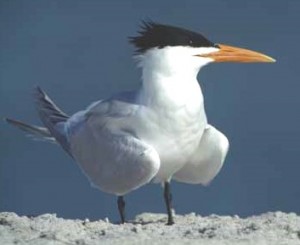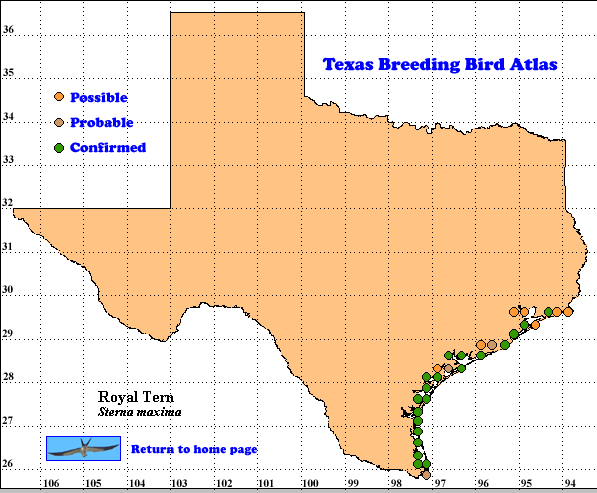Royal Terns are crested terns, a pan-tropical group of Old and New World species. They are characterized by crests, dense breeding colonies, variably downy chicks and juveniles, crèches (nurseries for pre-fledging chicks), extended parental care and delayed first breeding (Buckley and Buckley. 2002).
Royal Terns are often seen foraging inshore along barrier beaches, both ocean and back bay sides. They plunge-dive into salt water 1-2 m (3-7 ft) deep from a height of 5-10 m (16-33 ft) to capture fish and shrimp for themselves and their chick. They forage singly or in groups of 2-3 (Buckley and Buckley. 2002).
DISTRIBUTION. During the 1987-1992 field work seasons of the TBBA project, atlasers found 105 confirmed, 8 probable and 22 possible breeding sites for Royal Terns along or near the coast in the Coastal Prairies, Coastal Sand Plain and South Texas Brush Country regions (see the region map in Lockwood and Freeman [2004]).
This species breeds locally in colonies on barrier islands and other isolated locations along the Atlantic Coast from Virginia south to Florida and west along the Gulf Coast to Texas. Breeding also occurs in northwest Mexico (extending into extreme southern California) and southeast Mexico and throughout the West Indies. Other populations breed off southern South America and west Africa. Northern breeders winter along all North and Middle American and West Indian coasts from southern California and North Carolina to Panama and the Guianas. Non-breeders wander more widely (Howell and Webb 1995, Buckley and Buckley. 2002).
SEASONAL OCCURRENCE. Royal Terns are common residents along the Texas coast, breeding from late March to late July, based on egg collection dates from April 8 to June 18 and young in nests until July 22 (Oberholser 1974, Lockwood and Freeman 2004).
BREEDING HABITAT. In Texas Royal Terns breed along the coast around lagoons, islands and bays (Oberholser 1974)). Across their range they spend the year near ocean shores, breeding on inaccessible low-lying barrier or dredge-spoil islands, with excellent visibility of surrounding shallows for feeding. The terns prefer to nest in colonies, either single- or multi-species, on dry sand, shell banks, silt-covered gravel or dry seaweed. In these substrates the pair digs a shallow nest cup and in it the female usually lays one white to dark brown, heavily spotted egg in synchrony with nearby pairs. Ground color and pattern of spots varies extensively within colonies, enabling parents to recognize their egg. Both parents share incubation for a mean of 30-31 (range 28-35) days. The semi-precocial chick leaves the nest within 24 hours and joins a group of chicks in 2-3 days. Parents continue feeding their chick well into the winter as it is slow to develop foraging skills. Young Royal Terns remain on the wintering grounds for at least the first 2 winters before attempting to breed (Buckley and Buckley. 2002).
STATUS. The coastal distribution of the breeding and summer symbols on Oberholser’s (1974) map closely match those on the TBBA map. This species is a common resident along the Texas coast (Lockwood and Freeman 2004). Populations in North America are apparently stable and their future in Texas for now is probably secure. The heaviest mortality occurs during the winter when young birds become entangled in fishing lines, but the maximum lifespan of at least 27-28 years apparently compensates for this (Buckley and Buckley. 2002).
Text by Robert C. Tweit (2009)
Literature cited.
Buckley, P. A. and F. G. Buckley. 2002. Royal Tern (Sterna maxima), The Birds of North America Online (A. Poole, Ed.). Ithaca: Cornell Lab of Ornithology; Retrieved from: http://bna.birds.cornell.edu/bna/species/700
Howell, S. N. G. and S. Webb. 1995. A guide to the birds of Mexico and northern Central America. Oxford University Press, New York.
Lockwood, M. W. and B. Freeman. 2004. The TOS handbook of Texas birds. Texas A&M University Press, College Station.
Oberholser, H. C. 1974. The bird life of Texas. University of Texas Press, Austin.

